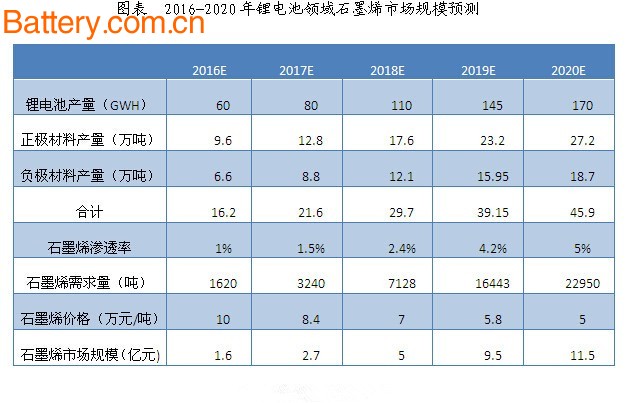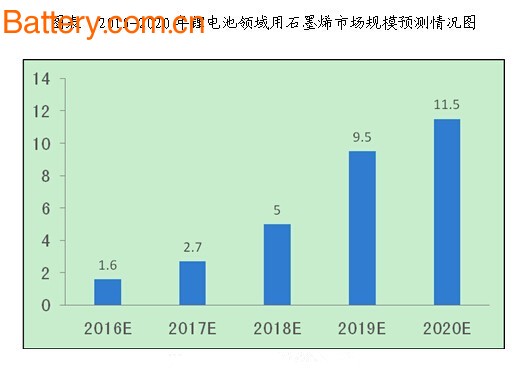At present, the main direction of developing and improving lithium ion batteries is to improve battery capacity and charge and discharge performance, improve battery safety and reduce electrode material costs. Lithium-ion batteries are mainly composed of a positive electrode, a negative electrode, a separator and an electrolyte, and the key to determining the overall electrochemical performance of a lithium ion battery is an electrode material. The application of graphene powder in lithium ion batteries is diversified. There are three main application directions, which are conductive additives for positive and negative materials, used in copper foil or aluminum functional coatings and as electrode materials. Commercially available, it has been used as a conductive additive in a positive electrode material to improve the electrical conductivity of the electrode material and to improve rate performance and cycle life. At present, graphene is mainly used as a conductive agent graphene in the field of lithium batteries. Calculated by weight percentage, the cathode material graphene 1% - 2% (mainly around 1%), if the cathode material uses lithium iron phosphate, the graphene accounted for about 2%, using graphene, the cost performance is improved, conductive Better sex, faster charge and discharge. In the application of lithium battery electrode materials, graphene anode materials are mainly composed of graphene composite materials. Graphite is a negative electrode material commonly used in lithium batteries. Graphite has a crystalline layered structure, which is easy to intercalate/deintercalate lithium ions, forming an interlayer compound LiC6, which is a stable negative electrode material, but its theoretical capacity is insufficient, which limits the capacity of the battery. Graphene has a high specific surface area and carrier mobility with a unique two-dimensional honeycomb crystal structure, which has great advantages in lithium storage, that is, lithium ions are reversible in the process of deintercalation, reducing the loss of cyclic specific capacity. , greatly improving the coulombic efficiency and cycle specific capacity of the battery. Graphene can be further prepared into a silicon-carbon composite anode material, which will once again improve the charge and discharge performance. However, due to limitations of application technology, graphene is currently used as a negative electrode material for lithium batteries, and the permeability of graphene in lithium battery anode materials is still low. With the rapid growth of new energy vehicle production, the gradual start of the energy storage lithium battery market, and the steady growth of consumer-grade lithium batteries, the demand for lithium batteries will also increase rapidly, stimulating the expansion of lithium battery capacity. It is estimated that by 2020, The annual output of lithium batteries can reach 170GWH. As the market demands for lithium batteries continue to increase, and the application technology of graphene in the field of lithium batteries is gradually upgraded, the proportion of graphene in lithium batteries will gradually increase. Estimated by the 5% content of graphene, the demand for graphene in the field of lithium batteries in 2020 is more than 20,000 tons. According to relevant research, 2016-2017 is the exploration period of graphene application in the field of lithium batteries, and the overall market penetration rate is relatively low. At this stage, the growth momentum of the industry is mainly due to the rapid expansion of lithium battery capacity brought by the rapid growth of new energy vehicles. . After 2017, the policy environment of new energy vehicles may change. The government's cancellation of subsidies for new energy vehicles is a high probability event, so lithium battery capacity will fluctuate and growth will slow down. However, the technical conditions for the use of graphene as a negative electrode material for lithium batteries at this stage are mature, the penetration rate of graphene in the field of lithium batteries will rapidly increase, the market scale will expand rapidly, and the market growth will be mainly driven by technology. In 2015, the price of graphene powder decreased by more than 90% compared with 2011. A research center predicts that the price of graphene powder will continue to decline in the next five years. The price of graphene powder will drop to 50,000 yuan/ton in 2020. The corresponding graphene market in the field of lithium batteries will exceed 1.1 billion yuan. Coatings And Paints,Anti Corrosion Pigments,Precipitated Silica For Paints Coatings,Precipitated Silica And Silicates Henan Minmetals East New Materials CO. LTD. , https://www.minmetals-easts.com
